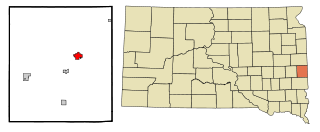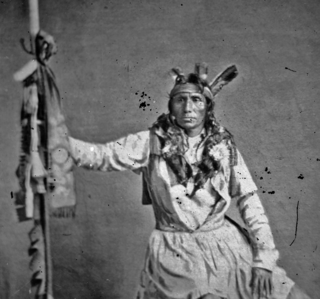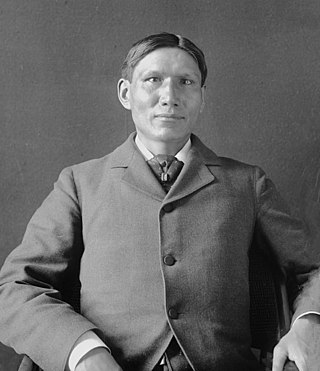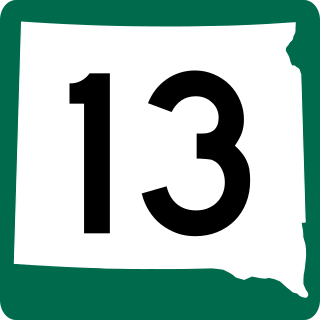
The Sioux or Oceti Sakowin are groups of Native American tribes and First Nations people from the Great Plains of North America. The Sioux have two major linguistic divisions: the Dakota and Lakota peoples. Collectively, they are the Očhéthi Šakówiŋ, or "Seven Council Fires". The term "Sioux", an exonym from a French transcription ("Nadouessioux") of the Ojibwe term "Nadowessi", can refer to any ethnic group within the Great Sioux Nation or to any of the nation's many language dialects.

Effigy Mounds National Monument preserves more than 200 prehistoric mounds built by pre-Columbian Mound Builder cultures, mostly in the first millennium CE, during the later part of the Woodland period of pre-Columbian North America. Numerous effigy mounds are shaped like animals, including bears and birds.

Moody County is a county in the U.S. state of South Dakota, United States. The population was 6,336 at the 2020 census. Its county seat is Flandreau. The county is named for Gideon C. Moody.

FlandreauFLAN-droo is a city in and county seat of Moody County, South Dakota, United States. The population was 2,372 at the 2020 census. It was named in honor of Charles Eugene Flandrau, a judge in the territory and state of Minnesota. He is credited with saving the community of New Ulm, Minnesota, from destruction during conflict with the Sioux tribe in 1862.

Little Crow III was a Mdewakanton Dakota chief who led a faction of the Dakota in a five-week war against the United States in 1862.
The Mdewakanton or Mdewakantonwan are one of the sub-tribes of the Isanti (Santee) Dakota (Sioux). Their historic home is Mille Lacs Lake in central Minnesota. Together with the Wahpekute, they form the so-called Upper Council of the Dakota or Santee Sioux. Today their descendants are members of federally recognized tribes in Minnesota, South Dakota and Nebraska of the United States, and First Nations in Manitoba, Canada.

The Dakota are a Native American tribe and First Nations band government in North America. They compose two of the three main subcultures of the Sioux people, and are typically divided into the Eastern Dakota and the Western Dakota.

South Dakota Highway 13 (SD 13) is a 23.835-mile-long (38.359 km) state highway in Moody and Brookings counties in the U.S. state of South Dakota. It connects Flandreau with Elkton. SD 13 was originally part of SD 11's path.

South Dakota Highway 32 (SD 32) is a 8.643-mile-long (13.910 km) state highway in Moody County, South Dakota, United States, connecting Interstate 29 (I-29) with Flandreau.
The Flandreau Santee Sioux Tribe are a federally recognized tribe of Santee Dakota people. Their reservation is the Flandreau Indian Reservation. The tribe are members of the Mdewakantonwan people, one of the sub-tribes of the Isanti (Santee) Dakota originally from central Minnesota.

The Flandreau Indian Reservation is an Indian reservation, belonging to the federally recognized Flandreau Santee Sioux Tribe of South Dakota. They are Santee Dakota people, part of the Sioux tribe of Native Americans. The reservation is located in Flandreau Township in central Moody County in eastern South Dakota, near the city of Flandreau.
Flandreau Creek is a 41.0-mile-long (66.0 km) river in Minnesota and South Dakota.
Dunlap Methodist Episcopal Church is a historic church in Brule County, South Dakota, located 12 miles north of Platte, South Dakota. It was built in 1902 and was added to the National Register in 2001.
St. Mary's Episcopal Church, also known as the Flandreau Indian School Chapel, is a historic church on North Crescent Street in Flandreau, South Dakota.
Cloud Man was a Dakota chief. The child of French and Mdewakanton parents, he founded the agricultural community Ḣeyate Otuŋwe on the shores of Bde Maka Ska in 1829 after being trapped in a snowstorm for three days. The village was seen by white settlers as a progressive step towards assimilation, yet members of the community maintained a distinctly Dakota way of life. The community was abandoned in 1839 and Cloud Man's band moved along the Minnesota River to join the Hazelwood Republic.
The Iowa–South Dakota League was a minor league baseball circuit that operated from 1902 to 1903 in the states of Iowa and South Dakota. The league was a Class D level league in both seasons. The Sioux Falls Canaries (1902) and Le Mars Blackbirds (1903) won the league championships.
The Crystal Theatre in Flandreau, South Dakota was built in 1913. It was listed on the National Register of Historic Places in 2000. It has hosted live vaudeville performances and film showings.
The St. Vincent's Hotel, at 100 North Wind in Flandreau, South Dakota, was built in 1897. It was listed on the National Register of Historic Places in 1983.
Flandreau Indian School (FIS), previously Flandreau Indian Vocational High School, is a boarding school for Native American children in unincorporated Moody County, South Dakota, adjacent to Flandreau. It is operated by the Bureau of Indian Education (BIE) and is off-reservation.










